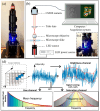Label-Free Optical Transmission Tomography for Direct Mycological Examination and Monitoring of Intracellular Dynamics
- PMID: 39590661
- PMCID: PMC11595662
- DOI: 10.3390/jof10110741
Label-Free Optical Transmission Tomography for Direct Mycological Examination and Monitoring of Intracellular Dynamics
Abstract
Live-cell imaging generally requires pretreatment with fluorophores to either monitor cellular functions or the dynamics of intracellular processes and structures. We have recently introduced full-field optical coherence tomography for the label-free live-cell imaging of fungi with potential clinical applications for the diagnosis of invasive fungal mold infections. While both the spatial resolution and technical set up of this technology are more likely designed for the histopathological analysis of tissue biopsies, there is to our knowledge no previous work reporting the use of a light interference-based optical technique for direct mycological examination and monitoring of intracellular processes. We describe the first application of dynamic full-field optical transmission tomography (D-FF-OTT) to achieve both high-resolution and live-cell imaging of fungi. First, D-FF-OTT allowed for the precise examination and identification of several elementary structures within a selection of fungal species commonly known to be responsible for invasive fungal infections such as Candida albicans, Aspergillus fumigatus, or Rhizopus arrhizus. Furthermore, D-FF-OTT revealed the intracellular trafficking of organelles and vesicles related to metabolic processes of living fungi, thus opening new perspectives in fast fungal infection diagnostics.
Keywords: fungal metabolism; invasive fungal infections; live-cell imaging; medical mycology; optical tomography.
Conflict of interest statement
The authors declare no conflicts of interest.
Figures






References
-
- Tochigi N., Sadamoto S., Oura S., Kurose Y., Miyazaki Y., Shibuya K. Artificial Intelligence in the Diagnosis of Invasive Mold Infection: Development of an Automated Histologic Identification System to Distinguish Between Aspergillus and Mucorales. Med. Mycol. J. 2022;63:91–97. doi: 10.3314/mmj.22-00013. - DOI - PubMed
LinkOut - more resources
Full Text Sources

